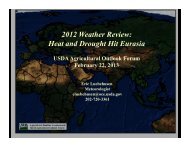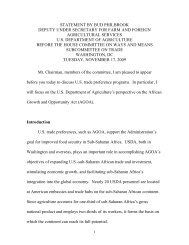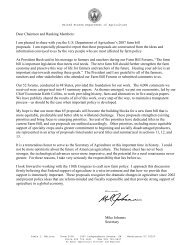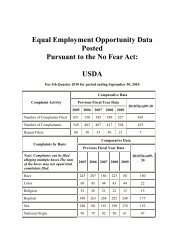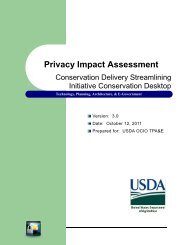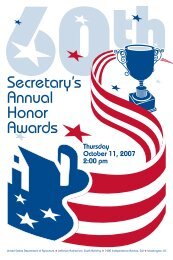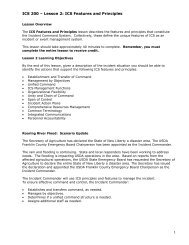ORDERING MANAGER J-252 - US Department of Agriculture
ORDERING MANAGER J-252 - US Department of Agriculture
ORDERING MANAGER J-252 - US Department of Agriculture
You also want an ePaper? Increase the reach of your titles
YUMPU automatically turns print PDFs into web optimized ePapers that Google loves.
<strong>ORDERING</strong> <strong>MANAGER</strong>J-<strong>252</strong>Job AidOctober, 2003NFES 1555
<strong>ORDERING</strong> <strong>MANAGER</strong>J-<strong>252</strong>Job AidOctober, 2003NFES 1555Sponsored for NWCG publication by the NWCG Training Working TeamComments regarding the content <strong>of</strong> this publication should be directed to:National Interagency Fire Center, National Fire Training Support Group, 3833S. Development Ave., Boise, Idaho 83705. Email:nwcg_standards@nifc.blm.gov.Additional copies <strong>of</strong> this publication may be ordered from National InteragencyFire Center, ATTN: Great Basin Cache Supply Office, 3833 South DevelopmentAvenue, Boise, Idaho 83705. Order NFES 1555.
TABLE OF CONTENTSINTRODUCTION......................................................4I. GENERALObtain and Assemble Materials Needed forKit .....................................................................7Documentation Forms ....................................7Miscellaneous Items ...................................... 8II.MOBILIZATIONA. Information from Local Dispatch Upon InitialActivation..........................................................9B. Gather Information ....................................... 10III.INCIDENT ACTIVITIESA. Incident and Check-in .................................. 11B. Briefing from Supply Unit Leader (SUPL) ...11C. Establish Ordering Procedures................... 13D. Written Request for Supplies andResources .................................................... 15E. Establish Ordering Channels ....................... 161
TABLE OF CONTENTS (continued)F. Maintain Filing System ................................. 19G. Reconcile Resource Orders ....................... 19H. Notification to Receiving and DistributionManager (RCDM) <strong>of</strong> Placed Orders ........... 20I. Briefing Subordinate(s) and ReliefPersonnel ..................................................... 21J. Coordination with Appropriate Personnel ... 22K. Reports Required by the SUPL .................. 23L. Evaluate Performance <strong>of</strong> Subordinate(s) ... 23IV.DEMOBILIZATIONA. Demobilization <strong>of</strong> Incident Supplies andEquipment .................................................... 23B. Demobilization <strong>of</strong> Ordering UnitPersonnel ..................................................... <strong>252</strong>
TABLE OF CONTENTS (continued)APPENDICESAppendix A, Check-out Authority .......................... 27Appendix B, ICS 213, General Message,Example ................................................................. 29Appendix C, Resource Order Examples andInstructions ............................................................. 31Appendix D, 24-Hour Clock .................................. 43Appendix E, Glossary <strong>of</strong> Terms andAcronyms .............................................................. 453
<strong>ORDERING</strong> <strong>MANAGER</strong> (ORDM)JOB AID, J-<strong>252</strong> INTRODUCTIONThe Ordering Manager has been identified as aposition within the Incident Command System(ICS). The J-<strong>252</strong> job aid, which supports thisposition, is part <strong>of</strong> the National WildfireCoordination Group's (NWCG), Wildland FireSuppression Curriculum. The subjects within theperformance based curriculum may beadministered by either an instructor led formaltraining course or by the use <strong>of</strong> job aids. It is highlysuggested that the trainee have previous incidentexperience.Job aids are "how to" books that assist an individualin performing specific tasks associated with aposition. They may be used by an individual, in atrainee position, who has met all <strong>of</strong> theprerequisites, but has not completed the positiontask book for that position. They are also used afterthe individual has become qualified, as an aid orrefresher in doing the job.The performance based qualification systemstipulates that an individual must complete aPosition Task Book prior to becoming qualified forthat position. Refer to the "Wildland andPrescribed Fire Qualification System Guide, PMS310-1" for the established standards for thisposition. It is recommended that this job aid beissued when the position task book is initiated.4
This job aid has been developed by an interagencydevelopment group with guidance from the NationalInteragency Fire Center, Fire Training underauthority <strong>of</strong> the NWCG, with coordination andassistance <strong>of</strong> personnel from the followingagencies:UNITED STATES DEPARTMENT OF THEINTERIORBureau <strong>of</strong> Land ManagementTrenna ButlerEd RyanMarianne SchappekUNITED STATES DEPARTMENT OFAGRICULTUREForest ServiceLynn BurtonDEPARTMENT OF NATURAL RESOURCESState <strong>of</strong> Wisconsin, Division <strong>of</strong> ForestryKen TerrillNATIONAL INTERAGENCY FIRE CENTERFire Training, NWCG Development UnitKarin NicholsJan HendrickWe appreciate the efforts <strong>of</strong> those peopleassociated with the development and review <strong>of</strong> thispackage.5
Sponsored for NWCG publication by the NWCGTraining Working Team, October, 2003.Comments regarding the content <strong>of</strong> this publicationshould be directed to: National Interagency FireCenter, Fire Training, 3833 South DevelopmentAvenue, Boise, Idaho 83705.Email: nwcg_standards@nifc.blm.govAdditional copies <strong>of</strong> this publication may beordered from: National Interagency Fire Center,ATTN: Great Basin Cache Supply Office, 3833 S.Development Avenue, Boise, Idaho 83705. OrderNFES #1555.6
I. GENERALObtain and Assemble Materials Needed forKit.Kit will be assembled and prepared prior toreceiving an assignment. Kit will containcritical items needed for functioning duringthe first 48 hours. Kit will be easilytransportable and within agency weightlimitation. Web gear or briefcase (not both)should not exceed 20 pounds. Pro<strong>of</strong> <strong>of</strong> Incident qualifications (Red Card) Position Task book, NFES 2353 Fireline Handbook, PMS 410-1, NFES0065 Expanded Dispatch Job Aid, NFES 2400 National Fire Equipment System Catalog,NFES 0362 Mnemonics data table National Mobilization Guide, NFES 2092Documentation Forms: ICS 213, General Message, NFES 1336 ICS 214, Unit Log, NFES 1337 ICS 219, Resource Status Card (T-Card),NFES 1342 and holder (optional) ICS 226, Individual Performance Rating,NFES 20747
II.MOBILIZATIONA. Obtain Complete Information From LocalDispatch Upon Initial Activation.1. Obtain a copy <strong>of</strong> the order form whichcontains:• Incident/Project name• Incident/Project order number• Office reference number (costcode)• Descriptive location/responsearea• Legal location (township, range,section)• Incident frequencies (if available)• Incident base/phone number(contact)• Request number• Reporting date/time and location,e.g., Incident Command Post(ICP)• Transportation arrangements androutes• Special instructionsRetain a copy <strong>of</strong> this order form for yourpersonal fire experience record.9
2. The individual will have:• Frameless s<strong>of</strong>t pack containingpersonal gear, not to exceed 45lb.• ORDM kit, not to exceed 20 lb.• Proper Personal ProtectiveEquipment (PPE) for the job.B. Gather InformationGather all available information necessary toaccurately assess incident; make appropriatedecisions about immediate needs andactions including:• Type <strong>of</strong> incident- Planned operations, e.g., multipleremote camps, burnoutoperations, water handlingoperations.• Current situation status• Expected duration <strong>of</strong> incident• Terrain• Weather (current and expected)10
III.INCIDENT ACTIVITIESA. Arrive at Incident and Check In• Locate supervisor (supply unit leader;SUPL.)• Report to status check-in recorder andcomplete ICS 211, Check-in List.• Report to the finance/administrationsection for time keeping procedures.B. Obtain Briefing from the SUPL.You are responsible for asking adequatequestions that will allow satisfactorycompletion <strong>of</strong> all job aspects. There are nostupid questions. Briefing should include asa minimum:• Sleeping and eating arrangements.• Location <strong>of</strong> your work area.• Copies <strong>of</strong> resource order forms <strong>of</strong>supplies and resources that have beenordered and received.• Personnel ordered for your function,work schedule, policy and operatingprocedures, and chain <strong>of</strong> command inyour unit.• Projections for additional personnel andequipment, approximate time andnumbers.11
• Responsible agency’s ordering policiesand procedures.• Sources <strong>of</strong> supplies- Where and with whom do I placeorders?• Phone number(s)?- Expanded dispatch- Agency dispatch <strong>of</strong>fice- Buying team- Incident - all functional areas- Vendor/contractor(s)- Fax numbers- Cache• People you will interface with on theincident.- Unit leaders and staff- Expanded dispatch- Buying team• Procurement lead times required forfood, tools, fuel, etc.• Type <strong>of</strong> communications available.- Fax, radios, phones, cell phones,computers• Location <strong>of</strong> computer work station(s), ifused.• Identify <strong>of</strong>fice needs.• Established/needed securityprocedures.• Procurement restrictions- Examples: flight suits, tents, brushjackets, commissary items,supplemental foods.12
• Establish briefing procedures within thesupply unit.• Request a current copy <strong>of</strong> the IncidentAction Plan (IAP) and incident map.Supply Unit LeaderOrderingManagerRecordersReceivingandDistributionRecordersHelpersTool andEquipmentSpecialistC. Establish Ordering Procedures.Tool Attendants• Identify who has ordering authority.- Crew boss, unit leaders, etc.See Appendix A, Check-out Authorityexample.• Identify the source from which you areordering supplies, e.g., expandeddispatch, direct to fire cache, or directto the buying team.• Identify type <strong>of</strong> tracking system beingused.• Ensure the consolidation <strong>of</strong> identicalsupply requests.- Check previous orders forduplication and verify forcorrectness.13
- Check with other unit leaders forpossibility <strong>of</strong> moving excessresources within the camp beforeordering more, e.g., portable toiletneeded for the helibase; checkwith the facilities unit leader(FACL).• Identify who is responsible forassigning request numbers, e.g.,ordering manager, expanded dispatch,buying team.• Follow resource order system fordocumenting requests for placementand completion <strong>of</strong> orders.• Verify with ordering unit for anysupplemental items that may berequired to complete an order.• Ensure that the person placing therequest has checked with receiving anddistribution for item(s) needed.• Coordinate ordering timeframes withexpanded dispatch or other orderingpoints.• If possible, meet face-to-face withagency personnel, e.g., expandeddispatch, buying team, and agencydispatch, you will be dealing with duringthese procedures.14
D. Receive Written Request for Supplies andResources Directly from Incident Personnelor Through the Incident CommunicationSystem.1. Request will be documented on a ICS213, General Message, legibly, andcontain the following information:• Request date/time and date/timeneeded.• NFES number (if applicable)• Detailed description <strong>of</strong> item(s).Be specific with model numbers,brand names, size, etc.• Number desired, units <strong>of</strong> issue• Any special billing requirements• Whom to notify when item isdelivered• Delivery point(s)• Name <strong>of</strong> requesting party andagency• Authorized approvalSee Appendix B, ICS 213 General Messageexample15
2. Evaluate and check for supplementalitems needed to complete therequested resource(s).• Examples <strong>of</strong> these supplementalitemsare:- Helitorch order - otherneeds may include: gas,helicopter, module,mixmaster.- 1 ½” & 1” Hose ordered -other needs may include:hose appliances, nozzles.- Leaf blower - other needsmay include: extensions,straps, fuel.3. Notify the SUPL <strong>of</strong> requests forresources placed by unauthorizedpersonnel before placing order.E. Place Resource Orders Through EstablishedOrdering Channels.1. After receiving request on a ICS 213,General Message, transfer informationonto an appropriate resource orderform.16
A – Aircraft, including:• air tankers• single engine air tankers (SEAT)• helicopters• large air transport• light fixed-wing• frequencies• Temporary Flight Restrictions(TFR)C – Crews, including:• hand (Type 1, 2, 2 IA)• camp• inmateO-Overhead, including:• incident management teams• technical specialists (THSP)E-Equipment- Major fire fighting andsupport items, including:• engines• dozers• caterers (food units)• contract showers• specialized itemsS-Supplies-, including:• NFES cache items- consumable, durable, andaccountable propertyitems• Items not available from the cache- rented items- local purchase items17
When all items are released, reassigned, or ifall supplies have been shipped, the order isready to close. The expanded dispatch andthe supply unit must review the order andensure all necessary documentation iscomplete and the resources have beenreleased.See Appendix C for examples <strong>of</strong> resourceorder forms and instructions for filling out thisform.2. Place order via telephone, fax or radio,to either expanded dispatch or otherordering point.3. Receive request number that has beenmutually agreed upon.• Record request number onto theoriginal ICS 213, GeneralMessage form and retain topcopy. Distribute the other copiesas follows:- Copy to receiving anddistribution for supplies.- Copy to the buying team ifapplicable.18
- Copy to requester whenorder has been confirmed.Notify requester <strong>of</strong> status <strong>of</strong>order, especially if problemsare encountered.F. Set up and Maintain Filing System.Establish a filing system to track:• The file system will be keptcurrent as resource orders areplaced or received.• File original copy <strong>of</strong> generalmessage(s) by individual days orunit placing the order.Whether the system is a series <strong>of</strong> boxes, apiece <strong>of</strong> canvas with pockets, or a filingcabinet, does not matter as long as it isfunctional and works as a status keepingsystem.G. Reconcile Resource Orders.• The ORDM is responsible forreconciling (balancing) orders.• Using the resource order form, withinthe established length <strong>of</strong> time, ensureconfirmation that previously placedorders have been filled, killed,outstanding, or canceled.19
• The ORDM must work closely with theRCDM, GSUL (ground support unitleader), resource unit, expandeddispatch, and buying team for feedbackon the arrivals <strong>of</strong> all items andpersonnel ordered.• Progressively document, check andconfirm all new and existing resourceorders, including delivery times,method <strong>of</strong> delivery and location.• Information is passed on to therequester as it becomes available.• All problems or questions are broughtto the SUPL and documented in the unitlog.H. Keep RCDM Informed <strong>of</strong> Orders Placed.• Ensure the pink copy <strong>of</strong> the ICS 213,General Message <strong>of</strong> suppliesrequested is given to the RCDM.• Update the RCDM <strong>of</strong> pending delivery<strong>of</strong> supplies.• Update the planning and logisticssection <strong>of</strong> overhead and crew arrivalsfor additional meals needed andsleeping arrangements.20
I. Brief Subordinates and Relief Personnel.1. Staff briefings:• Initial briefing• Daily briefing(s)- New personnel- Special problems, e.g.,injuries- Changes <strong>of</strong> policy andoperating procedures.- Upcoming operationalneeds, e.g., burnout, remotecamps- Outstanding orders- Canceled orders- Schedule changes- Safety concerns, e.g., work/rest compliance, nutrition,work environment.2. Methods <strong>of</strong> Communication• Briefings• ICS 211, Check-in list• ICS 213, General Message• ICS 214, Unit log• Resource order form• Waybills• Incident Action Plan (IAP)21
3. Communication should:• Be clear and concise• Ask questions• Get feedback• Verbally repeat orders to assureaccuracy• Include legible writingJ. Interact and Coordinate with AppropriateIncident Personnel.• Establish and maintain positiveinterpersonal and interagency workingrelationships.• Establish and maintain communicationwith other unit leaders and staff.• Recognize conflict early and takeappropriate action, e.g., seek the advice<strong>of</strong> the logistics section chief (LSC),SUPL, or human resource specialist(HRSP).• Recognize cultural language difficultiesthat impact work output andexpectations.• Integrate cultural resourceconsiderations into all activities.22
K. Prepare and Submit Reports as Required bythe SUPL.• Prepare ICS 214, Unit Log- Events that occur in the orderingunit.- A list <strong>of</strong> the ORDM’s staff.- Any major timetable problems.- Any new policy guideline changes.- Any problems encountered withsuppliers.• Submit documents in a timely manner tomeet deadlines and/or incidentrequirements.L. Evaluate Performance <strong>of</strong> Subordinate(s) asRequired by Agency Policy.• Performance evaluations are done forall unit personnel/crews prior to theirrelease from the incident. Performanceevaluations are discussed with theindividual(s).IV.DEMOBILIZATIONA. Demobilization <strong>of</strong> Incident Supplies andEquipment.Keep in mind demobilization begins when theincident starts23
1. Ongoing activities:• Refile orders in the “placed“ and“confirmed” files as their statuschanges.• Check and determine if unfilledorders are still needed.• Issue “S numbers” to crewsdemobilizing, if restock items arenot available at the incident, toenable them to order replacementitems at the home unit.2. Final demobilization:• Complete reconciliation <strong>of</strong> allresource orders.• Close out all resource orders andrecords with appropriate unit, e.g.,demobilization, expandeddispatch, initial attack aircraftdispatcher, procurement, buyingteam.• If receiving and distribution cannotrestock unusable supplies orequipment, receive OF-289,Property Lost or DamagedReport; then prepare OF-351,Incident ReplacementRequisition.24
• Turn all ordering records over tothe SUPL.• Provide the SUPL or LSCinformation on unreconciledorders or resources that havenot been demobilized for inclusionin the Transfer <strong>of</strong> Command Plan.This information should also beprovided to expanded dispatch.• Return all work materials to theappropriate unit.• Return your work area to its preincidentcondition.B. Demobilization <strong>of</strong> Ordering Unit Personnel.• Submit all required information to theSUPL.• Receive demobilization instructionsfrom the SUPL.• Brief replacement ORDM.• Debrief with supervisor and receivesigned performance appraisal.• Obtain ICS 221, DemobilizationCheckout, from the planning section.• Check out with each section indicatedon the ICS 221.• Submit completed ICS 221 to thedocumentation unit in the planningsection.25
APPENDIX ACHECKOUT AUTHORITY27
APPENDIX BICS 213, GENERAL MESSAGEChamberOrdering ManagerSmithDivision B SupervisorOrder <strong>of</strong> supplies 8/20 1945I need the following items for the day operational period, by 0600, 8/20I will pickup order1 ea. pump kit, NFES 06705 ea. reducers 1” x 3/4”, NFES 07335 ea. wye 3/4”, NFES 07395 ea. reducer 1 1/2” x 1”, NFES 00105 ea. nozzle 3/4” NFES 013610 LG Hose, garden, NFES 10165 LG Hose, 1”, NFES 09665 LG Hose, 1 1/2” , NFES 0114Smith, DIVS29
APPENDIX CRESOURCE ORDER, EXAMPLES31
APPENDIX C (continued)32
APPENDIX C (continued)33
APPENDIX C (continued)34
APPENDIX C (continued)35
APPENDIX C (continued)36
APPENDIX C (continued)37
APPENDIX C (continued)38
APPENDIX C (continued),39
APPENDIX C (continued)40
APPENDIX C (continued)41
APPENDIX D24-HOUR CLOCK12 Hour 24 Hour Pronounced1 AM ————— 0100 ——— Zero-one hundred2 AM ————— 0200 ——— Zero-two hundred3 AM ————— 0300 ——— Zero-three hundred4 AM ————— 0400 ——— Zero-four hundred5 AM ————— 0500 ——— Zero-five hundred6 AM ————— 0600 ——— Zero-six hundred7 AM ————— 0700 ——— Zero-seven hundred8 AM ————— 0800 ——— Zero-eight hundred9 AM ————— 0900 ——— Zero-nine hundred10 AM ————— 1000 ——— ten hundred11 AM ————— 1100 ——— eleven hundred12 NOON ——— 1200 ——— twelve hundred1 PM ————— 1300 ——— thirteen hundred2 PM ————— 1400 ——— fourteen hundred3 PM ————— 1500 ——— fifteen hundred4 PM ————— 1600 ——— sixteen hundred5 PM ————— 1700 ——— seventeen hundred6 PM ————— 1800 ——— eighteen hundred7 PM ————— 1900 ——— nineteen hundred8 PM ————— 2000 ——— twenty hundred9 PM ————— 2100 ——— twenty-one hundred10 PM ————— 2200 ——— twenty-two hundred11 PM ————— 2300 ——— twenty-three hundred12 Midnight——— 2400 ——— twenty-four hundredTo get 24 hour time, notice that you add 12 to the PM time to get the first twonumbers <strong>of</strong> the hour, i.e., 8 PM is twenty hundred (8 + 12 = 20).43
APPENDIX EGLOSSARY OF TERMS AND ACRONYMSFor additional fireline terms, refer to Wildland FireTerminology, PMS 205, NFES 1832AccountablePropertyA/CADAGLAIDSAir ContactAir ShowItems with a purchase price <strong>of</strong>$5,000.00 or more or items thatthe agency considers sensitive(cameras, chainsaws, items withproperty numbers).Aircraft, fixed or rotor wing.Administratively Determined (ratesand pay plan for emergencyworkers.)Above Ground Level, altitudeexpressed in feet above theground.Aerial Ignition Devices - usuallyrefers to a ping pong ball machineor a helitorch.Particular aviation resource tocontact when reporting to a fire.Multiple aircraft over a fire, usuallyincluding air tankers.45
APPENDIX E (continued)Air Tactical ICS position within the operationssection. Air Tactical GroupSupervisor (ATGS), synonymouswith air attack.AirA weather data collection andTransportable forecasting facility consisting <strong>of</strong>Modular Unit seven modules, weighing a total(ATMU) <strong>of</strong> 355 pounds and occupying34.2 cubic feet <strong>of</strong> space whentransported. Requires asupplemental order <strong>of</strong> helium,procured locally.Alumigel®ALSATAAir TankerATDJelly like substance produced bymixing gasoline and Alumigel®powder. It is then applied with anignition device such as a helitorchto ignite fires.Advanced Life SupportActual Time <strong>of</strong> ArrivalFixed wing aircraft capable <strong>of</strong>delivering fire retardant (liquid andfoam).Actual Time <strong>of</strong> Departure46
Av GasAzimuthBack HaulBaseBearingBackpackPumpBDUAPPENDIX E (continued)Fuel for aircraft with internalcombustion engines(reciprocating engines).The horizontal distance in angulardegrees in a clockwise directionfrom the north point.Excess supplies, equipment ortrash returned from a location onan incident.The location at which primarylogistical functions for an incidentare coordinated and administered.There is only one base perincident, e.g., incident commandpost (ICP).Position <strong>of</strong> an object withreference to a point on acompass.A collapsible backpack made <strong>of</strong>neoprene or high strength nylonfabric that carries approximatelyfive gallons <strong>of</strong> water fittedwith a hand pump. (bladder bag)Battle Dress Uniform; fire resistantpants47
APPENDIX E (continued)Black Water/ Vehicle capable <strong>of</strong> pumping andSewage Truck hauling raw sewage (black water)to certified sewage treatmentfacility.Booster Pump An intermediary pump forsupplying additional lift in pumpingwater uphill past the capacity <strong>of</strong>the first pump.Casual(EFF)Chief <strong>of</strong> PartyClamshellCompressedAirFoam System(CAFS)CommoAn employee who is picked uptemporarily for a fire emergency,see AD. Also referredto as Emergency Fire Fighter(EFF)Person in charge <strong>of</strong> passengerswhile traveling.Reusable battery holder for King®radios. Holds 9 AA batteries.Listed as Holder, Battery, King,NFES 1034.A generic term used to describefoam systems consisting <strong>of</strong> an aircompressor (air source), waterpump and foam solution.Communications48
APPENDIX E (continued)ConsumablePropertyCoordinationCenterItems that are expected to beconsumed on the incident(batteries, MREs, canteens).Regional/Zone/State level centerfor mobilization <strong>of</strong> resources toincidents, etc. (dispatch)Coupling, hose A fitting on the end <strong>of</strong> a hose thatconnects the ends <strong>of</strong> adjacenthoses or other components <strong>of</strong>hose, e.g., male, female, quickconnect, pin lug.Coyote Tactics A progressive line constructiontechnique involving self-sufficientcrews which build fire line until theend <strong>of</strong> the operational period,remain at or near that point while inan unavailable status and beginbuilding fireline at that point at thestart <strong>of</strong> the next operationalperiod.CSJRLCubieCotton-Synthetic Jacketed,Rubber Lined hose.Cubitainer: a five gallon containerused for transporting drinkingwater.49
DemobDHSDispatchDivisionDJRLDozerAPPENDIX E (continued)Demobilization, process <strong>of</strong>removing resources, usually <strong>of</strong>fincidents.<strong>Department</strong> <strong>of</strong> Homeland SecurityDispatch center; a facility fromwhich resources are assigned toan incident.Incident division, usuallydesignated by a letter, e.g.,Division A.Double Jacketed Rubber Linedhose.A tracked vehicle with a frontmounted blade used for buildingfireline; bulldozer.Dozer tenderBulldozer service unitDrum Lifter A device used to transport a 55gallon drum via a sling on ahelicopter.DurablePropertyNon-accountable items, withuseful life expectancy longer thanone incident.50
EngineEMSEMTETAETDETEExpandedDispatchFAAFBOAPPENDIX E (continued)A truck mounted with a pump andtank (water), used in firesuppression.Emergency Medical ServiceEmergency Medical TechnicianEstimated Time <strong>of</strong> ArrivalEstimated Time <strong>of</strong> DepartureEstimated Time En Route.The organization in dispatch that isactivated when the complexity <strong>of</strong>logistics coordination approachesa level the initial attack dispatchorganization can no longersupport.Federal Aviation AdministrationFixed Base Operator; usually thelocal airport.51
Fill or KillFire CacheFixed WingFLEFMOAPPENDIX E (continued)Policy designed to indicate abilityto fill an order or if it can not befilled within a reasonable amount<strong>of</strong> time (1 hour is standard), then“kill” it. Determine whetherto reorder at a later time or cancelthe order. This policy isreferenced in the NationalInteragency Mobilization Guide.A supply <strong>of</strong> fire tools andequipment assembled in plannedquantities or standard units at astrategic point for exclusive use infire suppression.Aircraft with stationary wings; anairplane.Fire Line Explosives, used forrapid construction <strong>of</strong> fire line witha small number <strong>of</strong> speciallytrained personnel.Fire Management Officer52
FoamAPPENDIX E (continued)An extinguishing agent, chemicallyand/or mechanically produced,that blankets and adheres to thefuels to reduce combustion.When foam products are mixed at1% or less, the foam will remaineffective at preventing ignition for12 hours. Works with currentclass A foam delivery systems.Fol-da-tank®FTSGated WyeGHTGorman RuppGray Water(Grey)GreenwichMeanTimeA portable, collapsible water tankwith a tubular frame; varies incapacity from 500-1500 gallons.Federal Telephone SystemA gated valve used in hose lays toallow connection <strong>of</strong> other hoseswithin the trunk line, e.g., 1” lateralhose with nozzle.Garden Hose Thread, 3/4 inchhose fittingsSmall, portable water pump.Used water from the kitchen andshower units.The time at “0” longitude,Greenwich, England (Zulu time).53
HazardousMaterialAPPENDIX E (continued)Substances that are identified,classified and regulated in theCode <strong>of</strong> Federal Regulations,Title 49 and Hazardous MaterialsRegulation 175. A hazardousmaterial is a substance or materialwhich has been determined by the<strong>Department</strong> <strong>of</strong> Transportation tobe capable <strong>of</strong> posing anunreasonable risk to health, safetyand property when transported incommerce and which has been sodesignated.Head (waterpressure)HelibucketHelitorchPressure due to elevation <strong>of</strong>water. Equals 0.433 pounds persquare inch per foot <strong>of</strong> elevation.Specially designed bucket carriedby a helicopter like a sling loadand used for aerial delivery <strong>of</strong>water or fire retardants.An aerial ignition device slungbeneath a helicopter to disperseignited lumps <strong>of</strong> jelled gasoline(Alumigel®).54
APPENDIX E (continued)Hot Food/ Nonreusable cans that are used toDrink Cans ship hot or cold drinks and food toremote locations.Hot Shots, IHC Specially trained seasonal handcrew (type 1).Hoverfill TankIAICImpellerIMSRIncidentLarge, portable tank from whichhelitankers can hoverfill.Initial Attack, first effort tosuppress a fireIncident CommanderRotating part <strong>of</strong> a centrifugalpump which imparts energy to theliquid to be moved. For shearingpurposes, the impeller is on arotating shaft within the body <strong>of</strong>liquid.Incident Management SituationReport (Sit Report). Daily reportgiving the current fire situation inthe United States.An event (fire, flood, earthquake,other disasters)55
APPENDIX E (continued)Incident An organization used to manageCommand an emergency incident or a non-System (ICS) emergency event. It can be usedequally well for both small andlarge situations. The system hasconsiderable internal flexibility. Itcan grow or shrink to meetdiffering needs. This makes it avery cost-effective and efficientmanagement system. Thesystem can be applied to a widevariety <strong>of</strong> emergency andnon-emergency situations.Incident Action Contains objectives reflecting thePlan (IAP) overall incident strategy andspecific control actions for thenext operational period. Theplan may be oral or written.IncidentOverheadIncreaserAll supervisory positionsdescribed in the incidentcommand system.Increasing coupling used onhose,pump or nozzles to permitconnection <strong>of</strong> a larger size <strong>of</strong>hose.56
InductorInfraredInsideDiameterIR ScanIron PipeStandardThreadKamlockAPPENDIX E (continued)A control mechanism that allows aregulated quantity <strong>of</strong> foamconcentrate to be introduced intothe main hose line.A heat detection system used forfire detection, mapping and heatsource identification.The internal diameter <strong>of</strong> a tube,conductor or coupling asdistinguished from the outsidediameter. Fire hose sizes areclassified by a nominal internaldiameter.Infrared survey <strong>of</strong> a fireStandard system <strong>of</strong> thread forconnecting various types <strong>of</strong> rigidpiping. These threads are muchfiner and more difficult to connectin the field than National Standardthreads.Type <strong>of</strong> fitting that provides quickconnecting/disconnecting hose.57
Lead LineLead PlaneLined FireHoseAPPENDIX E (continued)Line or set <strong>of</strong> lines made <strong>of</strong> rope,webbing or cable and used inhelicopter external loadoperations. Placed between aswivel or the cargo hook and theload.Aircraft with pilot used to maketrial runs over the target area tocheck wind, smoke conditions,topography and lead air tankersto the target.Fire hose with a smooth innercoating <strong>of</strong> rubber or plastic toreduce friction loss.LiquidConcentrateLive Lineor ReelLiquid phosphate fertilizers usedas fire retardants, usually dilutedthree to five times prior toapplication.Hose line or reel on a fire engine,carried connected to the pump,ready for use without makingconnection to pump or attachingnozzle.58
APPENDIX E (continued)LoadAn agency form used to calculateCalculation helicopter load weight.FormLocal AgencyAn agency having jurisdictionalresponsibility for all or part <strong>of</strong> anincident.Longline A line or set <strong>of</strong> lines, usually in 50feet increments, used in externalload operations that allow thehelicopter to place loads in areaswhich the helicopter can notland.MACMAFFSMark IIIMark 26MedevacMulti-Agency Coordinating GroupModular Airborne Fire FightingSystem, the military’s air tankerprogram (used when more tankersare needed than there areavailable on contract).Small, portable water pumpPortable water pump (smaller thana Mark III)Emergency medical evacuation59
APPENDIX E (continued)Misery Whip Crosscut sawMISTMix RatioMonitorMob GuidesMopupMREMulticomMudMinimum impact suppressiontacticsThe ratio <strong>of</strong> liquid foamconcentrate to water, usuallyexpressed as a percent.Turret type nozzle usuallymounted on an engine.Reference used to facilitate themobilization <strong>of</strong> resources.Includes policies, procedures,and where to find the resources.Extinquish or remove burningmaterial near control lines after anarea has burned to secure the fireor to reduce residual smoke.Meals Ready to Eat, light weight,packaged food used on firesA VHF/AM aircraft radio frequency(122.9 MHz) assigned by the FAAfor use in air-to-aircommunications.Fire retardant60
NHAPPENDIX E (continued)National Fire Hose, couplingthreads used for fire hose 1½"and larger.NFES CatalogNICCNIFCNomex®NozzleAspiratedFoam SystemReferred to as the National FireEquipment System Catalog. Thiscatalog is used to orderequipment and supplies from firecaches.National Interagency CoordinationCenter at Boise, ID.National Interagency Fire Centerat Boise, IDA fire resistant synthetic materialused in the manufacturing <strong>of</strong> flightsuits, pants and shirts forfirefighters.A foam generating device thatmixes air at atmospheric pressurewith foam solution in a nozzlechamber.Nozzle, Twin-tip combination nozzle for 1”Forester hose. Combination fog/straightstream nozzle tip; low volume.61
Nozzle, KKNPSHNPTNTEPayloadPAXPCPGPhoschek®APPENDIX E (continued)Combination barrel nozzle. Highervolume than the Forester nozzle.National Pipe Straight Hosecoupling threads (straight pipethreads for hose couplings andnipple).National Pipe Threads/AmericanStandard Taper pipe threadsNot to exceed; a personnel termused for positions that have alimited duration due to funding orproject length.Weight <strong>of</strong> passengers and/orcargo being carried by an aircraft.PassengersParacargo, cargo delivered bymeans <strong>of</strong> fixed wing aircraft andparachutes specialty packed andrigged, usually by smokejumperparacargo specialists.Personal gear bagLong term red colored fireretardant62
PICAPPENDIX E (continued)Pilot in CommandPiston PumpProbeye®ProportionerPSDPositive displacement pump with2, 4, and 6 reciprocating pistonsto force water from the pumpchamber in conjunction withappropriate action <strong>of</strong> inlet anddischarge valves.Infrared scanning device thatpicks up hotspots on fires.A device that adds apredetermined amount <strong>of</strong> foamconcentrate to water to form afoam solution.Plastic Sphere Dispenser - refersto a machine installed in ahelicopter that dispenses plasticspheres (ping pong balls) filledwith potassium permanganate.The machine injects a smallamount <strong>of</strong> ethylene glycol intoeach sphere and then dispensesthem out <strong>of</strong> the helicopter. Theexothermal reaction <strong>of</strong> the twochemicals creates enough heat toignite the plastic sphere, in 25 to30 seconds, which in turn ignitesthe fuel bed. Aerial SphereDispenser Kit, NFES 341063
PTOPumpkinRampRed CardReelResourceAPPENDIX E (continued)Power Take-Off, a supplementarymechanism enabling the enginepower to be used to operate nonautomotiveapparatus (such as apump).Collapsible, s<strong>of</strong>t-sided,freestanding portable water tank.Parking area for aircraft adjacentto a runway.Fire qualification card issued topersonnel showing theirqualifications to fill specificfire positions.A frame on which hose is wound(3/4 to 1 inch hose) supplied by awater tank on the apparatus.Any person, aircraft, supply orequipment available forassignment to an incident.Described by kind and type, e.g.,T2 Crew, ICT1, T6 Engine.64
ResourceOrderRespiratorRetardantRetrogradeRequisitionRHRocker LugCouplingAPPENDIX E (continued)Form used by dispatchers,service personnel and logisticscoordinators to document therequest, ordering or release<strong>of</strong> resources and the tracking <strong>of</strong>those resources on an incident.A simple filter mask for individualprotection against smoke andfumes for use on wildland fires.A chemical having a retardingaction on fire, usually applied withan air tanker.Reversal <strong>of</strong> an order; shippingsupply items from the incidentback to the cache or to anotherincident.A form/procedure for purchasingsupplies.Relative Humidity, a measure <strong>of</strong>moisture in the air.Hose coupling in which the lugsused for tightening or looseningare semicircular in shape anddesigned to pass overobstructions.65
APPENDIX E (continued)Rotor Wash The air turbulence caused by themovement <strong>of</strong> the rotor blades <strong>of</strong> ahelicopter.RotorwingRXSIPTSlurrySMJ or SJSOPSpotterStockingLevelsAircraft with a rotor system thatrotates about an axis to provide liftand/or thrust for a helicopter.Prescribed fireStraight Iron Pipe ThreadFire retardantSmokejumper; fire suppressionpersonnel who parachute to firesvia fixed wing aircraft.Standard Operating ProceduresSmokejumper supervisor incharge <strong>of</strong> a jumper load; performsnavigation, communication andparacargo duties.Minimum levels <strong>of</strong> supplies kepton hand at a fire cache.66
StrainerSurfactantSwamperT&AAPPENDIX E (continued)A wire or metal guard used tokeep debris from clogging pipe orother openings made for pumpingwater. Placed on suction hoseit will protect pumps from foreignmaterials.A surface active agent. Aformulation which, when added towater in proper amounts, willreduce the surface tension andincrease penetration capabilities<strong>of</strong> the water, e.g., wet water, classA foam, soap.Assistant to an equipmentoperatorTime and AttendanceTail NumberTankerFAA number used to identifyaircraft, located on the tail <strong>of</strong> theship. American aircraft tailnumbers begin with the letter N,e.g., N543TY, N67344.Air tanker67
TFRThreadTorch, DripAPPENDIX E (continued)Temporary Flight Restriction. Thisairspace restriction is obtainedthrough the FAA. It is an area <strong>of</strong>airspace over an incident that isdefined both laterally andvertically, which has beentemporarily or partially closed tononessential aircraft for a specificperiod <strong>of</strong> time.The specific dimensions <strong>of</strong> screwthread employed to couple firehose and equipment. AmericanNational Standard Hose Threadhas been adopted for firehose couplings.A hand-held device for ignitingfires by dripping flaming liquid fuelon the materials to be burned.Fuel used is generally a mixture <strong>of</strong>diesel and gasoline.Trash PumpUTFMedium sized pump used formoving large amounts <strong>of</strong> liquids,e.g., grey water, retardant. Thesepumps are ordered as volumepumps.Unable to fill; pertaining toresource orders.68
APPENDIX E (continued)Water Buffalo Liquid storage unitWater TenderWFSAWXXedar®Ground vehicle capable <strong>of</strong>transporting specified quantities<strong>of</strong> water, e.g., Type 1 watertender; 5000 gallon capacity, 300gallon per minute pumpingcapability.Wildland Fire Situation Analysis.An analysis tool used todetermine the mostappropriate management strategyfor a wildfire that has escapedinitial attack.WeatherType <strong>of</strong> heat seeking videodisplay unit that identifies hotspots during mopup.100 hour Mandatory maintenance done toaircraft every 100 hours (there isalso a 50 hour, 1000 hour, etc.)69
NOTES




